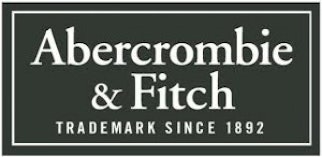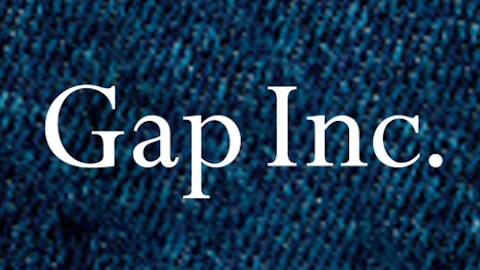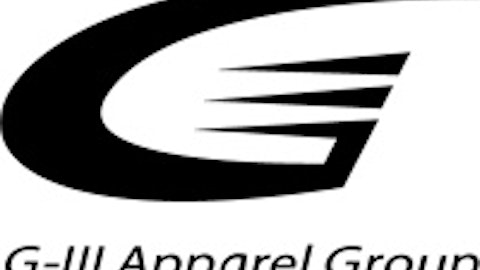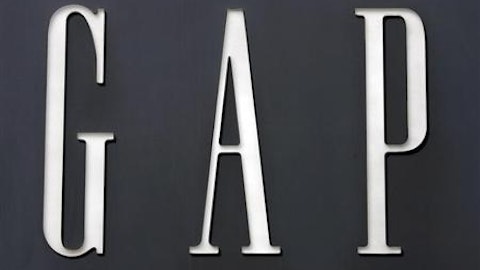Abercrombie & Fitch Co. (NYSE:ANF) is a specialty retailer that offers a wide range of casual apparel for men, women and kids. In this article we will explore what factors will prop up the company’s growth in the future and keep investors interested in the stock. With the U.S. economy exhibiting signs of improvement, consumer discretionary spending is expected to grow; therefore, going forward, retail stocks are expected to become lucrative investments.

I believe direct to consumer business will remain a key driver for apparel retailers for years to come, however, retailers will also benefit from better customer engagement through store productivity and international expansion.
During fiscal 2012, Abercrombie & Fitch Co. (NYSE:ANF) generated the highest percentage of its revenue through Hollister Stores, at around 43%, followed by Abercrombie & Fitch Co. (NYSE:ANF) stores, at around 32%. The remaining revenue was generated through the online channel and kids stores at around 15% and 9%, respectively.
Investors seeking to include an apparel retailer in their portfolio should definitely consider Abercrombie & Fitch Co. (NYSE:ANF), as the company has extreme growth potential through its direct to consumer segment and international expansion.
Growth trajectory
Abercrombie & Fitch Co. (NYSE:ANF) possesses a strong presence across Europe. It should be noted that the specialty retailer derives 25% of its revenue through international markets, of which a large portion is contributed through the European markets.
During fiscal 2012 and the first quarter of 2013, the international like for like sales dipped 8% and 16% respectively primarily due to a weak macroeconomic environment across the European region. The decline in revenue was also partly due to over expansion in few tourist spots, which resulted in sales cannibalization in spite of a reasonably limited store count across Europe. The company recently announced, to counter the drop in sales, it will now follow a passive expansion plan and only target underpenetrated or unexplored markets in order to offset the impact of cannibalization.
Other than Europe, Abercrombie & Fitch Co. (NYSE:ANF) is targeting markets such as UAE, Japan and Australia to launch its Hollister stores.
AT Kearney recently published a report, where it indicated that UAE’s per capita expenditure on clothing is one of the highest among all the developing markets across the globe. However, the apparel retail market in UAE is relatively smaller at around $6 billion approximately; nonetheless, it has exhibited a rapid growth rate during the last few years.
In stark contrast, the Japanese retail market stands at around $110 billion, but the growth exhibited relative to UAE’s apparel market is pale. It is worth noting that the Japanese market is experiencing a growing change in trends, where consumers are more inclined towards casual, economical clothing than expensive branded products. The cool biz campaign initiated by the government in order to reduce the air conditioning is further instigating consumers towards buying casual clothing. Such favorable trends in the Japanese market are expected to prop up its overall revenues.
Direct to Consumer will stimulate future growth
During the past three years, Abercrombie & Fitch’s direct to consumer segment has experienced a 35% year over year growth. Even though, direct to consumer business contributes only 15% to the overall revenues, the Trefis valuation estimates that direct to consumer segment holds approximately 40% value in Abercrombie & Fitch’s stock price.
The revenue share of this division is expected to grow exponentially in the coming years based on industry growth and the company’s initiative in making its online business a potent tool.
It is interesting to note that the U.S. represents approximately 34% of total global e-commerce sales, of which online shopping contributes 11%, which excludes groceries. Apparel and other related goods hold a massive 20% share in the total U.S. online retail sales. The outlook on the apparel sales through the online channel is highly optimistic, as eMarketer estimates the total online apparel market to grow from $45 billion during 2012 to $90 billion over the next four years.
Other than the U.S, Abercrombie & Fitch also possesses a robust presence across Europe, where, in spite of a weak macroeconomic environment, online retail sales is expected to follow a growth rate of around 11% over the next few years.
In addition, the retailer is making considerable efforts in strengthening its mobile commerce channel; during 2010 it made its website compatible to all internet enable devices coupled with a launch of its first iPad application. At present, mobile-commerce is a relatively small contributor to overall online sales; however, going forward it is expected to become a key revenue driver with growing popularity of smartphones and tablets.
Why invest in the retail sector?
In order to rationalize your investment in the apparel retail sector, it becomes essential to examine how other retailers are positioned to capitalize on the growth experienced in the direct to consumer channel.
Other than Abercrombie & Fitch, The Gap Inc. (NYSE:GPS) has also experienced tremendous growth through its direct to consumer channel. Similar to Abercrombie & Fitch, The Gap Inc. (NYSE:GPS) also launched its iPad application approximately three years back. Additionally, retailer’s mobile customized site enables its loyal customers to purchase online and locate nearby stores.
Recently, the company extended its omni-channel initiative to Old Navy, where online orders can be addressed through store inventory. Initially this particular service was only limited to The Gap Inc. (NYSE:GPS) and Banana Republic. Going forward, The Gap Inc. (NYSE:GPS) is expected to launch a new service called “Reserve in Store,” which predominantly allows customers to reserve their favorite items online and purchase them from nearby stores. The initiatives made by The Gap Inc. (NYSE:GPS) clearly exhibit its intent on bolstering its direct to consumer business.
Similarly, Urban Outfitters, Inc. (NASDAQ:URBN) is making considerable efforts to bolster its direct to consumer business. The company is experimenting by creating new catalog designs and offering an exclusive web based product mix.
The company benefited from an increase in its product assortments by approximately 50% during the first quarter of fiscal 2014. Furthermore, its new intimate apparel line has posted robust growth recently, as it now contributes a little over 15% to the overall e-commerce revenues.
Similar to The Gap Inc. (NYSE:GPS), Urban Outfitters, Inc. (NASDAQ:URBN) also offers an omni-channel service, which allows the company to address orders through store inventory. It is noteworthy, if the omni-channel service was not in place during the last quarter of the previous fiscal year, Urban Outfitters, Inc. (NASDAQ:URBN) would have experienced an order cancellation of approximately $12 million. Going forward, the company eyes its mobile-commerce channel as a primary driver behind online revenues, therefore, it has several initiatives lined up for the coming quarters.
The apparel retail sector will exhibit tremendous improvement with increasing employment leading to higher discretionary spending. Based on the efforts made by these apparel retailing giants to capitalize on the direct to consumer channel, I believe these three stocks will yield strong returns in the coming years.
Kiran Gulati and Equity Dimensions have no position in any stocks mentioned. The Motley Fool recommends Urban Outfitters. Kiran is a member of The Motley Fool Blog Network — entries represent the personal opinion of the blogger and are not formally edited.
The article The U.S. Retail Sector Is Primed to Benefit from the Direct to Consumer Channel originally appeared on Fool.com is written by Kiran Gulati.
Copyright © 1995 – 2013 The Motley Fool, LLC. All rights reserved. The Motley Fool has a disclosure policy.




